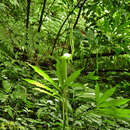pt-BR
nomes no trilho de navegação


Arisaema heterophyllum, the dancing crane cobra lily, belongs to the monocotyledonous flowering family Araceae.[1] It is a perennial, rhizomatous herb native to East Asia.[1][2] It has a spadix inflorescence and can be recognized by its green spathe and comparatively smaller central leaflet.[3]
The rhizome is often used in Chinese traditional medicine as a treatment for coughs, epilepsy, and tetanus.[3] It is prepared using ginger and potassium aluminum sulphate for purifying purposes.[4]
The roots are tubular, depressed globose shaped, and around 2–6 cm in diameter.[3] The usually solitary leaves are around 30–60 cm long, with glaucous petioles and sheathing adjacent to the pseudostem.[2] They are sedately divided, adaxially dull green and abaxially pale green, and contain 4 or 5 cataphylls and multiple leaflets, ranging from 11 to 21 in number.[2] The central leaflet is 3–15 cm long and 0.7-5.8 cm wide; the outermost leaflets are smaller. The distance between leaflets is around 0.5–5 cm.[2] The leaves have a variety of shapes, such as oblanceolate, oblong, linear-oblong, base cuneate, and apex cuneate.[3]
The peduncle of the flower is around 50–80 cm long, and is usually longer than the petiole.[3] The flower also has a spathe tube that is cylindrical, 3.2–8 cm long, 1-2.5 cm wide, outside glaucous, inside whitish green, and its throat is slightly recurved.[2] The spadix of the flower is either bisexual or monoecious and male.[3] In the female part of the bisexual spadix it has a punctate stigma, a distinct style, and a globose ovary that contains 3 to 4 ovules; the male part contains sterile flowers.[3] The anthers of the male spadix has thecae dehiscing by the apical slits.[3] The pale white sigmoid appendix is 20 cm long, ascending, and gradually tapers from the sessile base to sharp apex.[2] The flowering period usually starts in April or May, and continues from July to September.[3] The fruits are cylindrical yellowish red or red berries that usually have 1 seed.[3]
Arisaema heterophyllum is native to East Asia, including China, Inner Mongolia, Japan, and Korea.[5] In China, it is grown across different provinces except for the Northwest region and Tibet.[6] In Japan, it is grown in Honshu and Kyushu.[7]
The species tends to grow in evergreen and deciduous riparian forests, shrublands, wetlands (inland) or grassland where shade is available and moisture is retained.[1][7] It is closely associated with flood plains and prefers humus-rich and well-draining soil. The tuber is intolerant to low temperatures.[1] In Japan, it is considered a threatened species due to the loss of riparian forest along the major rivers of Kanto Plain.[8]
The plant contains Arisaema heterophyllum agglutinin (AHA),[9] a substance that can cause blood particles to coagulate and aggregate. It was revealed that AHA had negative effects towards the feeding behaviour of the Indian Grain Aphid (Sitobion miscanthi), causing the aphids' lifespan to reduce significantly.[9] Resistance towards Indian Grain Aphids in wheats was observed to have improved after intruding AHA to the plants.[9]
Many species within the genus Arisaema have medicinal uses in Chinese medicine.[3]
Arisaema heterophyllum, the dancing crane cobra lily, belongs to the monocotyledonous flowering family Araceae. It is a perennial, rhizomatous herb native to East Asia. It has a spadix inflorescence and can be recognized by its green spathe and comparatively smaller central leaflet.
The rhizome is often used in Chinese traditional medicine as a treatment for coughs, epilepsy, and tetanus. It is prepared using ginger and potassium aluminum sulphate for purifying purposes.
Arisaema heterophyllum là một loài thực vật có hoa trong họ Ráy (Araceae). Loài này được Blume mô tả khoa học đầu tiên năm 1836.[1]
Arisaema heterophyllum là một loài thực vật có hoa trong họ Ráy (Araceae). Loài này được Blume mô tả khoa học đầu tiên năm 1836.
Arisaema heterophyllum Blume, (1836)
СинонимыАризе́ма разноли́стная, или Аризе́ма манжу́рская (лат. Arisaéma heterophyllum) — многолетнее травянистое клубнелуковичное растение, вид рода Аризема (Arisaema) семейства Ароидные (Araceae).
Клубнелуковичные многолетние травянистые растения.
Клубень сжато-шаровидный, 2—6 см в диаметре.
Катафиллов 4 или 5, чешуйчатые.
Лист обычно один. Черешок сизый, 30—60 см длиной, примерно на ¾ вложенный во влагалище, образующее ложный стебель. Листовая пластинка пальчаторассечённая на 11—19(21) листочков, короткочерешчатых или сидячих, бледно-зелёных снизу и тускло-зелёных сверху, различной формы, ланцетовидных, продолговатых или линейно-продолговатых, клиновидных в основании, заострённых на вершине; центральный листочек 3—15 см длиной, 0,7—5,8 см шириной, часто намного короче боковых; крайние внешние листочки 7,7—24,2(31) см длиной, (0,7)2—6,5 см шириной, следующие листочки постепенно уменьшающиеся; расстояние между листочками 0,5—5 см.
Цветоножка обычно длиннее черешка, 50—80 см длиной. Трубка покрывала сизая снаружи, беловато-зелёная внутри, цилиндрическая, 3,2—8 см длиной, 4—9 см шириной.
Початки двуполые или мужские. Двуполый початок: женская зона примерно 1—2,2 см длиной; завязь шаровидная; столбик заметный; рыльце точечное; семяпочек 3 или 4; мужская зона 1,5—3,2 см длиной; синандрий рыхлый; иногда со стерильными цветками. Мужской початок: мужская зона 3—5 см длиной, 3—5 мм шириной; синандрий стебельчатый, состоящий из двух или трёх пыльников, каждый из них с двумя теками, вскрывающимися верхушечными разрезами. Придаток возрастающий, сигмоидальный, бледно-беловатый, постепенно сужающийся от сидячего основания до очень острой вершины, примерно 20 см длиной, 5—11 мм в диаметре у основания.
Цветёт в апреле — мае.
Плоды — желтовато-красные или красные, цилиндрические ягоды около 5 мм длиной. Семя обычно одно, булавовидное.
Ягоды созревают в июле — сентябре.
Распространены в Южном и Центральном Китае, Японии (Хонсю, Кюсю, Шикоку), Корее и на Тайване[2].
Встречаются в лесах, чащах, на полянах, на высоте до 2700 м над уровнем моря.
Аризе́ма разноли́стная, или Аризе́ма манжу́рская (лат. Arisaéma heterophyllum) — многолетнее травянистое клубнелуковичное растение, вид рода Аризема (Arisaema) семейства Ароидные (Araceae).
天南星(学名:Arisaema heterophyllum)是天南星科天南星属的植物。
多年生有毒草本;块茎略呈球形;掌状复叶,披针形小叶;夏季开花,肉穗花序外包紫色或绿色佛焰苞;浆果多数,成熟时为鲜红色。
分布于朝鲜、日本以及中国大陆的除西北和西藏外的大部分省区等地,生长于海拔300米至2,700米的地区,见于灌丛或草地。
中医上以球茎入药,性温、味苦辛,有毒,功能祛风化痰,主治中风、破伤风、小儿惊风、风痰癫痫等症;外敷痈肿。
本品研末用牛胆汗拌制而成,称“胆南星”,性凉、味苦,功能清火化痰、镇惊定痫,主治惊痫、痰厥、风痰、眩晕等症。